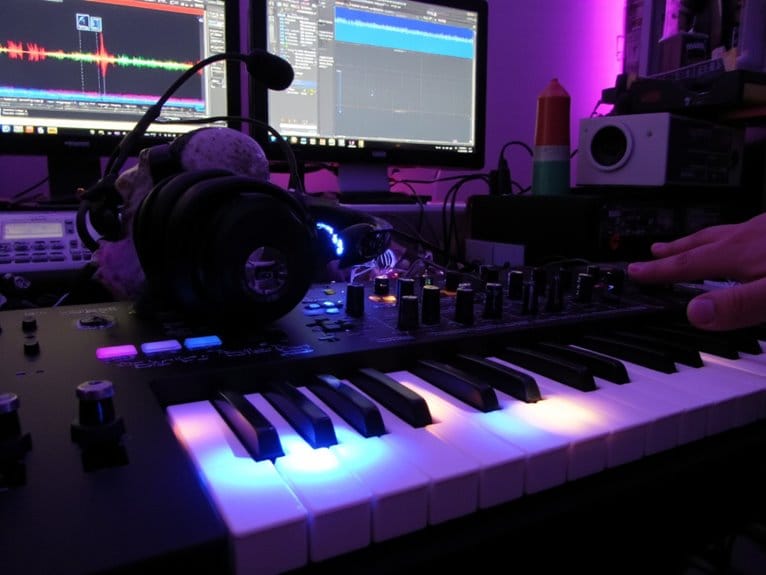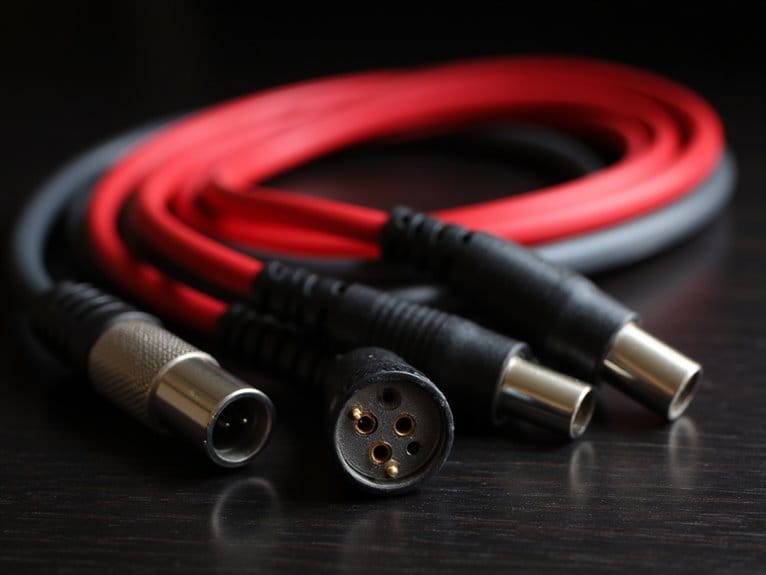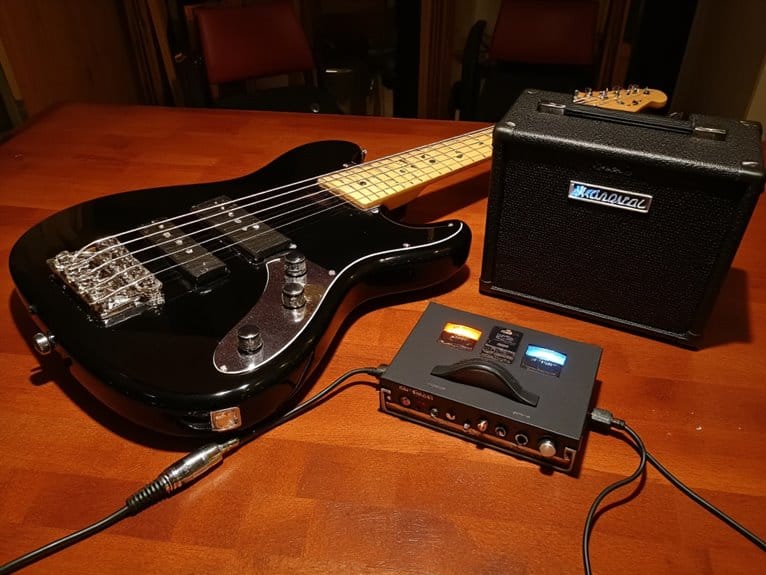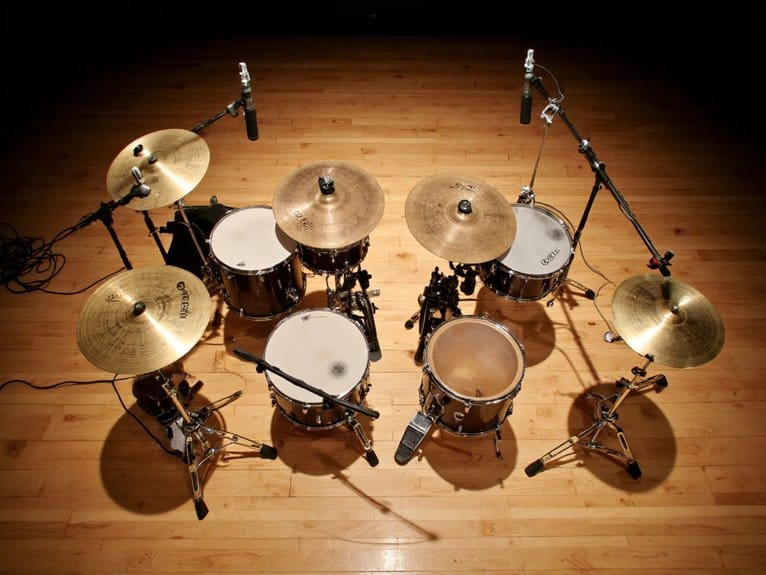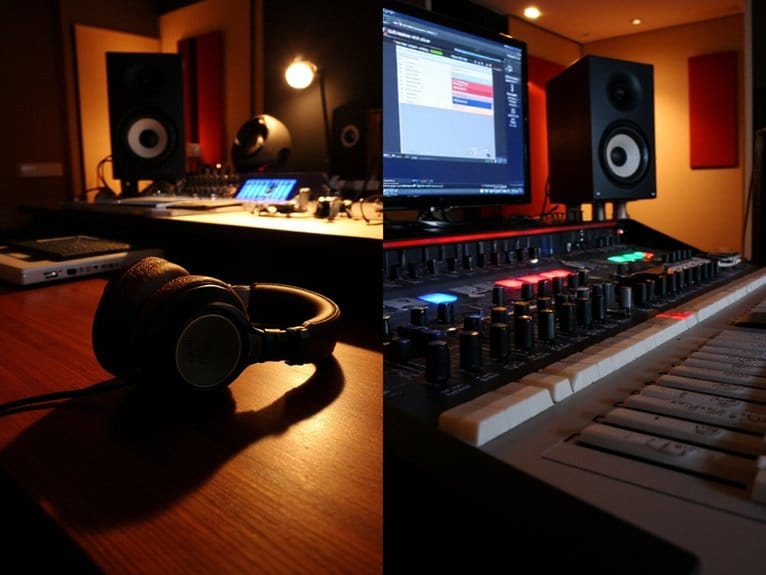Latency Issues in Digital Audio Workstations
You’ll experience latency issues in your DAW when the round-trip delay between input and output exceeds 10-12 milliseconds, primarily caused by buffer size settings, audio interface conversion processes, and plugin processing loads. Lower your buffer size from 512 to 128 samples for recording, use ASIO drivers for better performance, and enable direct monitoring on your interface to bypass digital delays entirely. Strategic buffer management and hardware optimization can transform your workflow from frustrating to fluid. Investing in rofessional sound mixers for travel can enhance your recording capabilities without sacrificing quality. These mixers often come equipped with features that minimize latency while allowing for seamless integration with mobile devices.
We are supported by our audience. When you purchase through links on our site, we may earn an affiliate commission, at no extra cost for you. Learn more.
Notable Insights
- Buffer size settings directly affect latency; reducing from 512 to 128 samples significantly decreases monitoring delay during recording.
- Audio interface connection type matters, with USB generally having higher latency than FireWire or Thunderbolt connections.
- Direct monitoring through hardware interfaces bypasses digital processing entirely, enabling true zero-latency tracking for performers.
- CPU-intensive plugins increase processing delays; freezing heavy tracks frees resources and reduces overall system latency.
- ASIO drivers improve communication between audio interfaces and computers, enhancing both stability and latency performance.
Understanding the Root Causes of Audio Delay
Although I’ve spent countless hours troubleshooting frustrating audio delays in my studio, I’ve learned that latency in digital audio workstations stems from several interconnected factors that you can actually control once you understand what’s happening behind the scenes.
Your audio interface acts as the primary bottleneck, with USB connections typically introducing more delay than FireWire or Thunderbolt alternatives due to slower data transfer rates.
Your audio interface becomes the weakest link in your signal chain, with connection type directly impacting the delays you’ll experience during recording and playback.
Digital conversion processes, where your analog signals transform into digital data and back again, add inherent delays that compound throughout your signal chain.
Buffer size settings create a delicate balancing act between latency and system stability, while plugin efficiency varies dramatically depending on algorithmic complexity, with look-ahead compressors and linear phase EQs contributing significant processing delays.
Using ASIO drivers instead of generic Windows drivers can markedly reduce latency by optimizing how your audio interface communicates with your computer.
Measuring and Calculating System Latency
The moment you decide to tackle latency measurement in your DAW, you’ll discover that pinpointing exact delay times requires more precision than simply noticing that your recordings feel sluggish during playback.
Measuring latency becomes straightforward when you understand the basic formula: latency equals buffer size divided by sample rate, multiplied by two for round-trip processing. However, calculating delay involves more than this simple math, since A/D and D/A converters add approximately 3-5 milliseconds beyond your calculated values.
You can use loopback tests, clapping tests, or specialized RTL utilities to capture thorough system measurements. Most modern DAWs include built-in latency monitoring tools, though dedicated analysis software provides the most accurate results for identifying specific delay sources within your signal chain.
Balancing Performance Trade-offs
Once you’ve mastered measuring your system’s latency, you’ll face the perpetual challenge of optimizing performance without sacrificing audio quality or system stability.
CPU performance becomes your primary battleground, where single-core speed trumps multi-core benchmarks for real-time audio processing.
Storage optimization revolves around SSDs, which eliminate the playback glitches that spinning drives introduce during complex sessions with heavy sample libraries.
Buffer management requires constant adjustment-lower settings reduce latency but stress your CPU, while higher buffers provide stability at the cost of responsiveness.
Your audio interface acts as the essential bottleneck, where proprietary ASIO drivers and direct monitoring features can bypass DAW processing entirely.
Similarly, hardware amplifiers like small combo amplifiers often include direct monitoring capabilities that eliminate digital processing delays entirely. This feature allows musicians to hear their playing in real-time, providing a more accurate representation of their sound. Additionally, many of these amplifiers offer outputs specifically designed for use with headphones for guitar amp setups, making them versatile for practice or recording environments. This flexibility enhances the overall playing experience, ensuring that artists can focus on their sound without any disruptions.
I’ve learned that finding the sweet spot means constantly tweaking these interconnected variables based on your specific workflow demands.
Practical Solutions for Latency Reduction
When you’re ready to tackle latency head-on, buffer size optimization becomes your most immediate and powerful tool. Dropping from 512 to 128 samples can slash your monitoring delay from roughly 10.7ms to 2.7ms at 48kHz-though you’ll pay for this responsiveness with increased CPU demands that might destabilize your system during complex sessions.
Effective buffer management requires strategic switching between recording and mixing phases, while driver optimization through manufacturer-specific ASIO drivers delivers consistent performance that generic alternatives simply can’t match.
- Install native ASIO drivers from your interface manufacturer for rock-solid stability
- Enable direct monitoring to achieve true zero-latency tracking during recording sessions
- Freeze CPU-heavy tracks once finalized to reclaim processing power instantly
- Maintain consistent sample rates across all devices to eliminate conversion delays
On a final note
You’ve now got the knowledge to tackle latency head-on, though I’ll admit it’s not always as straightforward as we’d like it to be. By understanding your system’s limitations, measuring actual delay times rather than guessing, and implementing targeted solutions like ASIO drivers and buffer optimization, you’ll dramatically improve your recording experience. Remember, it’s about finding that sweet spot between low latency and stable performance.

